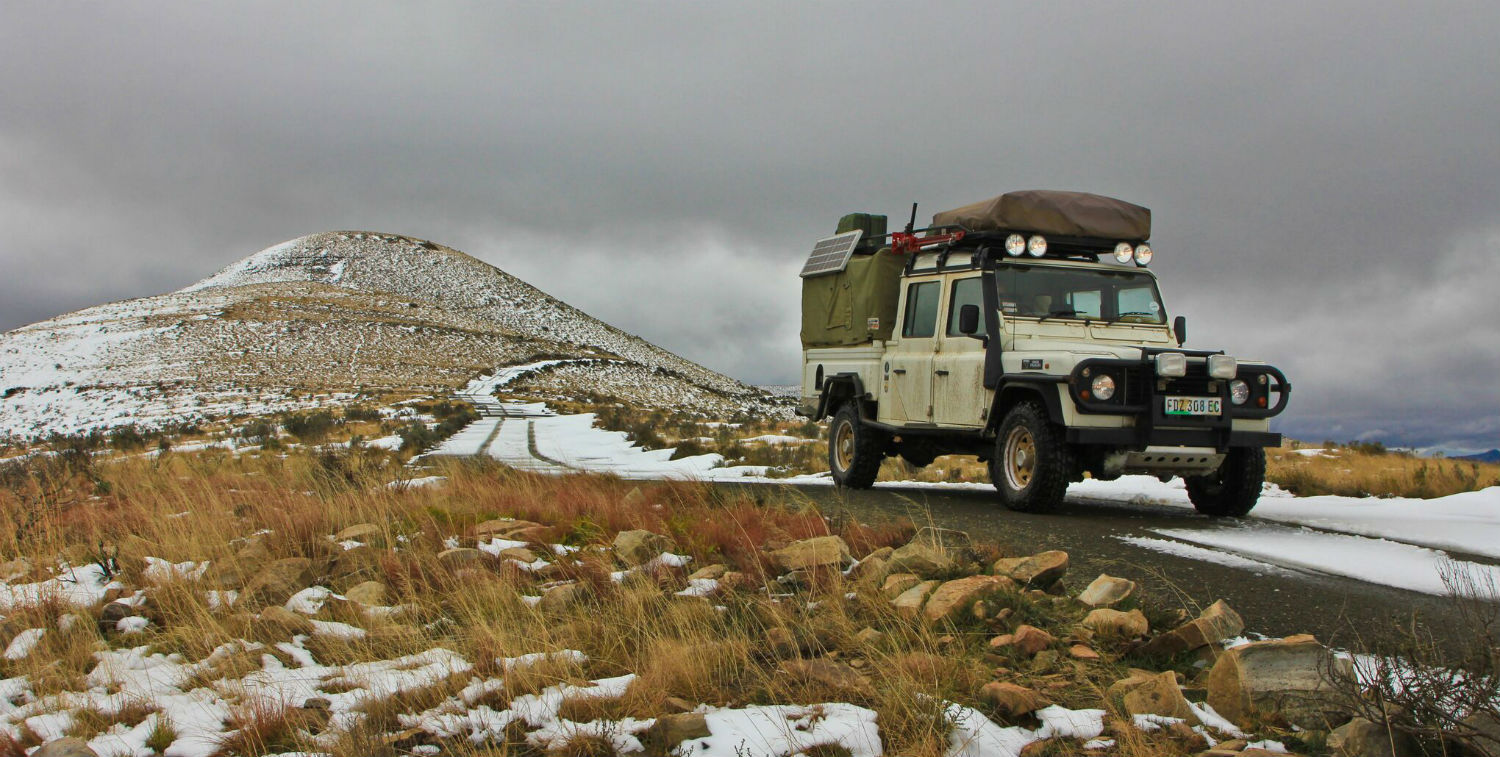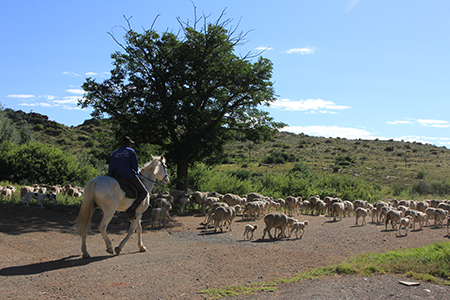
The Mountain Zebra Wilderness Corridor Partnership
05 November 2017
Overview
We envisage a world that has sufficient intact natural ecosystems and wilderness areas that are valued and effectively protected for the benefit of all species.
- Wilderness Foundation
The Mountain Zebra Wilderness Corridor Partnership
Cape Mountain zebra, black wildebeest, cheetah and black rhino ― these flagship species are just a few that roam through the grassland habitat between Mountain Zebra National Park and Camdeboo National Park Complex in South Africa’s Eastern Cape Province.
The area also includes the Sneeuberg Center of Endemism, where 1,288 indigenous plant species have been identified, including 29 endemics (species that can only be found here).
In May 2012, the Wilderness Foundation and South Africa National Parks (SANParks) launched the Mountain Zebra Wilderness Corridor Partnership, with support from the Critical Ecosystem Partnership Fund (CEPF) through its investment in the Maputaland-Pondoland-Albany biodiversity hotspot.
Landowners between the two national parks were engaged in the project to formally protect their land while maintaining current land use, which includes livestock farming, small-scale crop production for grazing fodder and hay, hunting and ecotourism. When the project began, there were more than 50 properties between the two parks, consisting of mostly farms and a few private conservation areas.

Other benefits to landowners include protection against mounting threats to the environment and potential assistance with habitat management, including veld management and erosion control.
Project Quick Facts
Grantee: Wilderness Foundation
Recognizing that the protection and sustainability of South Africa’s unique wilderness areas and natural heritage is dependent on socio-political and economic conditions within society, the Wilderness Foundation takes a holistic approach to implementing its mandate for conservation.
Focusing on four main program areas (conservation; social intervention; experiential education, and advocacy and awareness), the foundation creates opportunities to encourage, plan and protect wilderness, uplift the knowledge and lives of citizens, and stimulate an environmental ethos among current and future leaders.
Purpose: Work with South Africa National Parks to create a mosaic of protected areas anchored by the Mountain Zebra National Park and the Camdeboo National Park Complex, a key biodiversity area in South Africa. To place as much as 30,000 hectares of land under formal stewardship, the Wilderness Foundation will work with as many as 75 landowners in the area.
Grant Amount: $216,690
Grant Term: 03/12 – 02/14
Contact: Matthew Norval, Conservation Program Director, Wilderness Foundation
Resources:



Conservation Results

This innovative initiative involved extensive consultation with landowners and other stakeholders in the region, resulting in an improved perception of SANParks and conservation in general. Conservation is now seen as a legitimate land use and an approach that is compatible and beneficial to the extensive rangeland grazing practices ― the most common agricultural practice in the region. This has laid the foundation for further engagement and an enduring conservation ethic.
To date, 69 landowners are directly involved in the corridor, with 284,627 hectares of privately owned land in the corridor now protected under signed contractual or voluntary agreements. The footprint of the area extends even farther, covering about 530,000 hectares, including an important bird area, four biomes and six major vegetation types.
“By partnering with SANParks and private landowners, we have successfully protected unique and valuable ecosystems, as well as the species dependent on the four biomes ― grassland, savanna, Nama Karoo and thicket ― between the two national parks,” said Norval.
Although the South African Department of Environmental Affairs has not yet signed the formal declaration to finalize establishment of the protected environment within the corridor, this process is underway and approval is expected by the end of 2014. This will formally recognize 268,428 hectares as a Protected Environment under the Protected Areas Act, ensuring assistance with habitat management, partial protection against prospecting and other potentially harmful activities, and marketing and branding opportunities that can be explored as part of the broader corridor.
In the meantime, the corridor expansion is contributing to improved conservation management within the area, taking into account sustainable use of the land, grazing, soil erosion and the control of invasive species. The corridor is also expected to help secure the provision of ecosystem services for local communities, such as the development of ecotourism activities and job creation.
An unexpected outcome not foreseen by the Wilderness Foundation was the overwhelming reaction from landowners against fracking. The landowners instead favor a low impact conservation/rangeland grazing as the land use for the region. Since much of the area has been identified as having potential for exploration of shale gas by fracking, formal protections will help shield the region from this threat.




Lessons Learned

Lesson 1: Cooperation + consistent messaging
To implement the project, a small management team provided guidance to the on-the-ground project manager. It was critical that all members of the project team had a similar understanding of the project so that the message delivered to stakeholders and landowners was consistent. This allowed for rapid decision-making and evaluation of scenarios as they arose. It also helped to ensure that the views and input from a number of different sources were captured.
Another key component to project implementation was the excellent cooperation between the team members from SANParks, Eastern Cape Parks and Tourism Agency and the Wilderness Foundation. SANParks staff provided legal and land negotiation input and contributed to the project’s spatial planning requirements.
The ongoing input and support of the two park managers from SANParks was vital to ensure that the corridor is seen as a priority for the conservation potential of the parks they manage, and for the greater good of the region.
To streamline the Protected Environment process and help ensure approval, the management team agreed that a project delegation would personally take all necessary paperwork to the South African Department of Environmental Affairs.
Lesson 2: Building relationships + capturing local knowledge
Although park managers and staff of the Mountain Zebra and Camdeboo national parks provided local knowledge of the area and its people, the project team members also had to build relationships with stakeholders and landowners in order to influence behavior that will be positive for conservation in the region.
In many cases, the landowners are third generation stock farmers with a well-developed sense of conservation and matters likely to impact future generations. In order to capture their local knowledge, the project management team members “made it clear that we were there to learn as well,” according to Norval.
Allowing the landowners to raise concerns and interact directly with the project team was crucial to the project’s success. Regular updates were provided to the landowners involved, which helped provide a sense of cohesion and understanding during the lengthy corridor proclamation process.
This willingness to work and learn together with local stakeholders was clearly demonstrated when two Wilderness Foundation staff members attended a holistic grazing course alongside local farmers. This helped show that the team was working on conservation with local landowners rather than for them, by respecting their knowledge and working for the long-term good of the area.



Sustainability

The Mountain Zebra Wilderness Corridor has generated collaboration between the landowners and the two anchor national parks, Mountain Zebra and Camdeboo. The project’s success has also laid the foundation for future opportunities to add land parcels to the corridor. Although this area is identified as a conservation priority in the National Protected Areas Expansion Strategy, it is not without threat.
To help protect the corridor from potential fracking in the future, the Wilderness Foundation established an alliance of nongovernmental organizations to oppose this hydraulic fracturing technique. This alliance will also promote conservation and tourism as a sustainable alternative to fracking.
To support project activities once CEPF funding has concluded, the foundation is looking into applying for funding from the Global Environment Facility (GEF). SANParks is also working in partnership with the Development Bank of South Africa to identify potential green projects within the corridor that would give the initial efforts additional environmental, social and economic benefits.
Partnerships were also developed with two groups active in the Karoo in order to promote sustainability:
- Karoo Space has promoted tourism in the area, publishing articles that position the corridor as an important component of the conservation/tourism mix, and will continue to do so in the future.
- Treasure the Karoo Action Group (TKAG) has promoted community education and awareness of both human and environmental rights associated with fracking.





